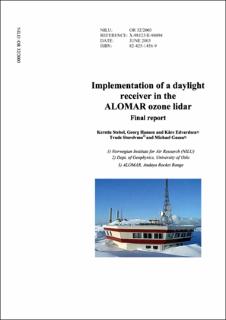Implementation of a daylight receiver in the ALOMAR ozone lidar. Final report.
| dc.contributor.author | Stebel, Kerstin | |
| dc.contributor.author | Hansen, Georg Heinrich | |
| dc.contributor.author | Edvardsen, Kåre | |
| dc.contributor.author | Storelvmo, Trude | |
| dc.contributor.author | Gausa, Michael | |
| dc.date.accessioned | 2020-12-11T12:55:14Z | |
| dc.date.available | 2020-12-11T12:55:14Z | |
| dc.date.issued | 2003 | |
| dc.identifier.isbn | 82-425-1456-9 | |
| dc.identifier.issn | 0807-7207 | |
| dc.identifier.uri | https://hdl.handle.net/11250/2717321 | |
| dc.description.abstract | During summer 1998 the stratospheric ozone DIAL (Differential Absorption Lidar) at the Arctic Lidar Observatory for Middle Atmosphere Research (ALOMAR, Andøya, 69.28ºN, 16.01ºE) has been equipped with a daylight receiver, which partly has been financed by the European Space Agency (ESA). This report briefly describes the ozone lidar daylight system and discusses its current state. Recent ozone measurements and first satellite validation results are presented. Nowadays, lidar measurements of high quality can be performed at any time of the day and the year at ALOMAR. Reliable ozone density profiles can be measured during full daylightconditions up to a maximum altitude of 36 km (optimal conditions: 42 km) from less than 2 hours of continuous measurements (night-time: the maximum altitude is ca. 50 km, about 1 hour averages). This enables the station to be a well-suited ground reference site for validation of satellites with polar orbits. | |
| dc.language.iso | eng | |
| dc.publisher | NILU | |
| dc.relation.ispartof | NILU OR | |
| dc.relation.ispartofseries | NILU OR;32/2003 | |
| dc.subject | Fjernmåling | |
| dc.subject | Ozonlaget og UV | |
| dc.subject | Atmosfære og klima | |
| dc.subject | Andøyaobservatoriet | |
| dc.title | Implementation of a daylight receiver in the ALOMAR ozone lidar. Final report. | |
| dc.type | Research report | |
| dc.rights.holder | © NILU | |
| dc.source.issue | 32/2003 | |
| dc.relation.project | NILU:98123 |
Tilhørende fil(er)
Denne innførselen finnes i følgende samling(er)
-
NILU oppdragsrapport (1970-2015) [1724]
Rapporter i den avsluttede serien NILU oppdragsrapport (NILU OR).
